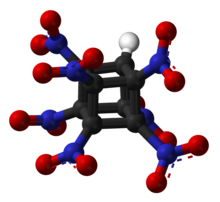 | |
 | |
| Names | |
|---|---|
| Preferred IUPAC name
1,2,3,4,5,6,7-Heptanitrocubane | |
| Identifiers | |
3D model (JSmol)
|
|
| ChemSpider | |
PubChem CID
|
|
CompTox Dashboard (EPA)
|
|
| |
| |
| Properties | |
| C8HN7O14 | |
| Molar mass | 419.131 g·mol−1 |
| Hazards | |
| Occupational safety and health (OHS/OSH): | |
Main hazards
|
Explosive |
| Related compounds | |
Related compounds
|
Cubane Octanitrocubane 2,4,6-Tris(trinitromethyl)-1,3,5-triazine 4,4’-Dinitro-3,3’-diazenofuroxan Hexanitrohexaazaisowurtzitane |
Except where otherwise noted, data are given for materials in their standard state (at 25 °C [77 °F], 100 kPa).
| |
Heptanitrocubane /ˌhɛptəˌnaɪtroʊˈkjuːbeɪn/ is an experimental high explosive based on the cubic eight-carbon cubane molecule and closely related to octanitrocubane. Seven of the eight hydrogen atoms at the corners of the cubane molecule are replaced by nitro groups, giving the final molecular formula C8H(NO2)7.
As with octanitrocubane, not enough heptanitrocubane has been synthesized to perform detailed tests on its stability and energy. It is hypothesized to have slightly better performance than explosives such as HMX, the current high-energy standard explosive, based on chemical energy analysis. While in theory not as energetic as octanitrocubane's theoretical maximum density, the heptanitrocubane that has been synthesized so far is a more effective explosive than any octanitrocubane that has been produced, due to more efficient crystal packing and hence higher density.[1]
Heptanitrocubane was first synthesized by the same team who synthesized octanitrocubane, Philip Eaton and Mao-Xi Zhang at the University of Chicago, in 1999.[2]
References
[edit]- ^ Gejji, Shridhar P; Patil, Ujwala N; Dhumal, Nilesh R (2004). "Molecular electrostatic potentials and electron densities in nitrocubanes C8H8−α(NO2)α (α=1–8): Ab initio and density functional study". Journal of Molecular Structure: THEOCHEM. 681 (1–3): 117–127. doi:10.1016/j.theochem.2004.05.012.
- ^ Mao-Xi Zhang; Philip E. Eaton; Richard Gilardi (2000). "Hepta- and Octanitrocubanes". Angewandte Chemie International Edition. 39 (2): 401–404. doi:10.1002/(SICI)1521-3773(20000117)39:2<401::AID-ANIE401>3.0.CO;2-P. PMID 10649425.
Further reading
[edit]- Bashir-Hashemi, A.; Higuchi, Hiroyuki (2009). "Chemistry of Cubane and Other Prismanes". PATAI's Chemistry of Functional Groups. doi:10.1002/9780470682531.pat0333. ISBN 9780470682531.